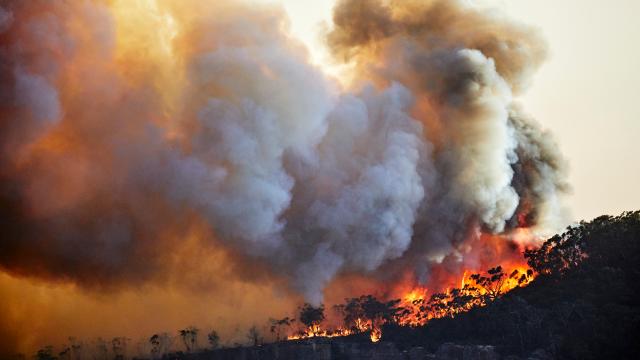Hey, remember last month when the Intergovernmental Panel on Climate Change (IPCC) released its latest report and essentially confirmed that the state of the planet is worse than we thought? Well, it turns out there was actually a teeny, tiny silver lining that got lost in the report: the ozone layer.
The ozone layer, and the holes we burn in it through greenhouse gas emissions, is likely one of the first things you were ever taught about climate change back in primary school, so it’s nice to know that our action in reducing ozone depletion is actually working. And, at least in the short-term, this action is helping to offset some of the immediate impacts of climate change.
Meet SAM
This is all the result of the Southern Annular Mode (SAM), which is a belt of strong westerly winds in the Southern Hemisphere that plays a significant role in the climate and rainfall we experience right here in Australia — and across the globe.
Basically, the SAM’s position on the globe (whether it moves north or south) has a direct impact on where storms, cold fronts, heavy rainfall and temperature changes are experienced.
You can watch this video from the Australian Bureau of Meteorology for a more in-depth explanation of how the SAM actually works.
So What Does This Mean For Us?
According to Australian Antarctic Division principle research scientist Andrew Klekociuk, we’ve been in a “tug-of-war between ozone recovery and the effects of greenhouse gas increases”.
But thankfully, the lessening of the southern trend that was referenced in last month’s IPCC report is a step in the right direction for humanity. As Monash University climate science professional Julie Arblaster told the ABC, it’s a “really good news story”, which is what we all need to hear right now.
“We, as humans, are doing a big chemistry experiment on our planet at the moment and anything we can do to reduce our impact on the climate system has to be of benefit,” Arblaster said.
“Bringing the [rainfall and storm systems] back equator-ward would certainly help return some of the rainfall patterns to their normal location.”
[related_content first=”1717898″]
What Will Summer Look Like?
Like Sean Paul, we’re all looking for the right temperature to shelter us from the wild weather we’ve experienced in summers past. As for what that temperature will actually be, it sort of depends on where you live.
Overall, our efforts to minimise ozone depletion have been helpful to preventing global temperatures rising to catastrophic levels. However, specific conditions vary depending on your location.
When the SAM is closer to Antarctica, the eastern states generally experience wetter, windier conditions. So, now that we’ve hit reverse on the trend, we can expect less rainfall over summer.
However, the same can’t be said for Tasmania and New Zealand, which is expected to be rainier than usual as a result of the SAM.
But it’s worth noting that the SAM isn’t the only thing that plays a part in Australia’s weather conditions, so don’t go planning your sunny BBQs just because of this data.
“Different regions have influences from many things and not just the SAM trend,” Arblaster said. “For example, the El Nino Southern Oscillation.
“So there is a strong understanding of how the ozone hole has affected the SAM, but how much influence ozone depletion has had on Australian rainfall trends is still a question.”
So… Climate Change Is Fixed?
Absolutely not, unfortunately. But you can think of this as a little bit of a buffer.
This is helpful right now, but it doesn’t mean we can go back to not caring about the planet, and these benefits won’t last if we don’t continue to reduce our greenhouse gas emissions.
“If we don’t reduce emissions soon, the greenhouse gases will overwhelm any impact from ozone recovery by the end of the 21st Century,” Arblaster said.
Basically, this is why the IPCC report didn’t lead with the good news because although it’s great to know that our efforts are starting to make a difference, we absolutely cannot afford to get complacent when it comes to climate change.
You can read more about the IPCC report here.
